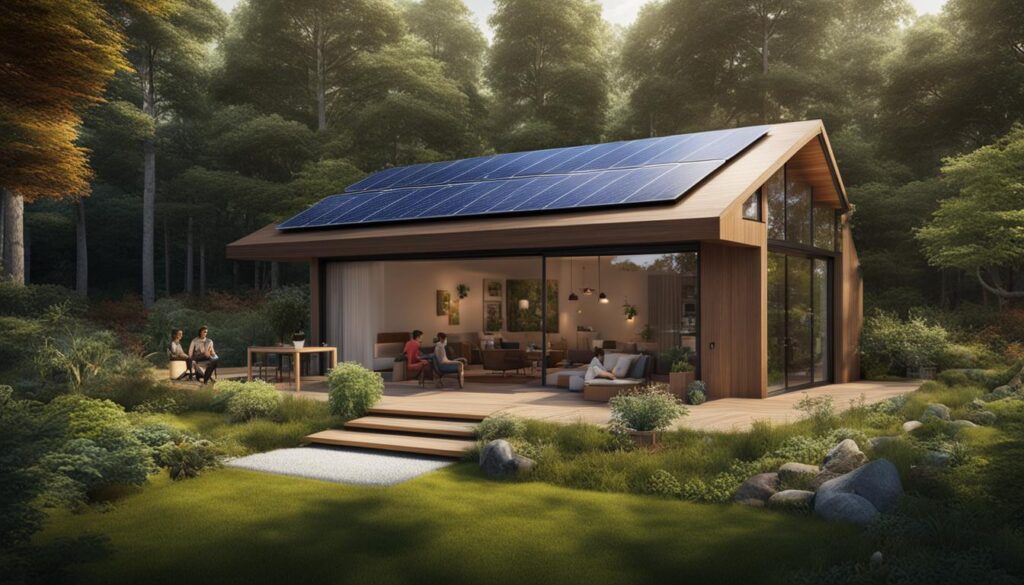We may earn money or products from the companies mentioned in this post.
As our planet faces the challenges of climate change, the importance of sustainable and eco-friendly properties continues to grow. These environmentally friendly homes are built using green building practices, sustainable real estate, eco-conscious developments, energy-efficient homes, green home features, sustainable living, eco-friendly construction materials, and green architecture, all aimed at creating a healthier and more sustainable future.
Living sustainably not only benefits the planet, but also promotes healthier and happier living. Sustainable properties offer energy-efficient homes, green spaces, and community initiatives that minimize waste and reduce carbon footprints. By embracing green living, we can all contribute to a more sustainable future.
Key Takeaways:
- Environmentally friendly homes can be achieved through green building practices and sustainable real estate.
- Energy-efficient homes and green home features contribute to reducing energy consumption and minimizing waste.
- Eco-conscious developments prioritize sustainability in community initiatives, waste management systems, and green spaces.
- Investing in sustainable properties offers benefits such as reduced energy costs, improved indoor air quality, and increased property value.
- Green building practices and eco-conscious developments will shape the future of sustainable living.
Understanding Sustainable Real Estate
Sustainable real estate is a growing trend in the real estate industry that focuses on creating properties that are environmentally friendly and energy efficient. This approach to real estate development involves the use of eco-friendly construction materials and green architecture to minimize the environmental impact of buildings while promoting a more sustainable future.
Eco-friendly construction materials are those that have a reduced impact on the environment. These materials are often made from renewable resources and are designed to be long-lasting and durable. Examples of eco-friendly construction materials include bamboo, recycled steel, and straw bale.
Green architecture focuses on creating buildings that are designed to be energy efficient and sustainable. This type of architecture incorporates energy-saving features, such as natural ventilation and lighting, to reduce energy consumption. It also incorporates sustainable design elements, such as green roofs and rain gardens, to manage stormwater and promote biodiversity.
By incorporating sustainable building practices and eco-friendly construction materials, sustainable real estate is leading the way in promoting a more sustainable future.
Embracing Green Living
To fully embrace sustainable living, it’s crucial to incorporate energy-efficient features into your home design. Not only do these features promote a more eco-friendly lifestyle, but they can also save you money on utility bills in the long run.
Energy-Efficient Homes
Energy-efficient homes are designed to minimize energy consumption and reduce waste. These homes feature appliances and fixtures that are built to use less energy, such as LED light bulbs, low-flow showerheads, and Energy Star certified appliances. Insulation, weather stripping, and high-efficiency windows are also common features of energy-efficient homes.
Living in an energy-efficient home has several benefits. In addition to reducing your carbon footprint, you’ll also enjoy lower energy bills and improved comfort. These homes are designed to keep the temperature consistent throughout the year, which means you won’t have to rely on heating and cooling systems as much as you would in a standard home.
Green Home Features
Green home features are another way to promote sustainability in your living space. These features can include anything from a rainwater harvesting system to composting facilities and green roofs. Other common green home features include solar panels, smart home technology, and sustainable building materials.
Green home features not only help minimize your environmental impact, but they also improve the overall health and well-being of those living in the property. For example, plants on green roofs can help filter out pollutants from the air, while natural light in the home can boost mood and productivity.
“Living in an energy-efficient home has several benefits. In addition to reducing your carbon footprint, you’ll also enjoy lower energy bills and improved comfort.”
When considering green home features, it’s essential to work with a builder or contractor who has experience with sustainable building practices. This will ensure that the features are installed correctly and effectively.
| Benefits of Green Home Features | |
|---|---|
| Reduced energy costs | Improved air quality |
| Higher property value | Less environmental impact |
| Improved health and well-being | Lower water usage |
Overall, incorporating energy-efficient and green home features into your property is a significant step towards sustainable living. Not only will it benefit the environment, but it can also improve your own quality of life. By investing in sustainable living, you’re investing in a healthier and more sustainable world.
Eco-Conscious Developments
Eco-conscious developments are a crucial part of sustainable and eco-friendly properties. These communities prioritize sustainability and rely on green building practices to minimize their environmental impact.
Efficient Waste Management Systems
Eco-conscious developments implement efficient waste management systems to reduce waste and promote responsible disposal. These communities often prioritize recycling and provide ample resources for residents to recycle easily.
Green Spaces
Another crucial aspect of eco-conscious developments is the incorporation of green spaces, such as parks and gardens. These spaces can serve as a haven for residents and a natural filter for air and water pollution. By prioritizing green spaces, eco-conscious developments also promote sustainable living and encourage residents to appreciate and protect nature.
Community Initiatives
Eco-conscious developments often organize community initiatives to engage residents and promote sustainability. These initiatives may include community gardens, composting, and educational programs on green living. By fostering a sense of community and shared responsibility, eco-conscious developments can contribute to a more sustainable future.
Smart Buildings
In addition to eco-conscious practices, sustainable properties often incorporate smart building technology to reduce energy consumption and promote sustainability. These features may include automated lighting and temperature control systems, as well as energy-efficient appliances and technologies. By minimizing energy waste and promoting sustainable living, eco-conscious developments can create healthier, more efficient living spaces for residents.
Benefits of Sustainable and Eco-Friendly Properties
Investing in sustainable and eco-friendly properties comes with a multitude of benefits for homeowners. From reducing energy costs to promoting a healthier living environment, here are some of the advantages of environmentally friendly homes:
| Benefit | Description |
|---|---|
| Lower Energy Costs | Energy-efficient homes utilize green technology and appliances that consume less energy, resulting in lower utility bills and long-term savings for homeowners. |
| Improved Indoor Air Quality | Sustainable properties often feature advanced ventilation and air filtration systems that promote better indoor air quality and a healthier living environment for residents. |
| Reduced Carbon Footprint | By using eco-friendly construction materials and green building practices, sustainable homes have a smaller carbon footprint than traditional homes and can significantly reduce your environmental impact. |
| Increased Property Value | Studies have shown that green homes have a higher resale value than conventional homes, making them a smart investment for homeowners. |
Sustainable living is not just about reducing your carbon footprint, but also about creating a healthier and more comfortable living space for you and your family. By embracing environmentally friendly homes and sustainable living practices, you can enjoy a better quality of life while contributing to a more sustainable future.
The Future of Sustainable Living
As we move towards a more eco-conscious future, the real estate industry must also adapt to meet the growing demand for sustainable living. Green building practices and eco-conscious developments are becoming increasingly popular, offering a more sustainable and healthier lifestyle for homeowners.
The Rise of Green Building Practices
Green building practices have been gaining traction in recent years, with builders and architects exploring innovative ways to reduce the environmental impact of buildings. From using eco-friendly construction materials to implementing energy-efficient designs, these practices aim to create sustainable properties that promote a healthier living environment.
As the demand for sustainable properties continues to grow, we can expect to see more builders and architects adopting these green building practices. This, in turn, will promote more sustainable living and contribute to reducing our carbon footprint.
The Impact of Eco-Conscious Developments
Eco-conscious developments are another trend that is shaping the future of sustainable living. These developments aim to create sustainable communities that prioritize eco-friendliness, from efficient waste management systems to green spaces and community initiatives.
As homeowners seek out more sustainable living options, we can expect to see more eco-conscious developments emerging. These developments not only promote sustainable living but also foster a sense of community, creating a more fulfilling and meaningful living experience for residents.
The Intersection of Sustainable Living and Technology
Another aspect of the future of sustainable living is the intersection of technology and sustainability. With advancements in technology, we can expect to see more innovative solutions emerging that promote sustainable living.
For instance, smart home technology can help homeowners reduce their energy consumption by allowing them to control their home’s devices and systems remotely. In addition, renewable energy sources such as solar panels may become more accessible in the years to come, offering homeowners a more sustainable way to power their homes.
The Future is Green
As we look ahead to the future of sustainable living, it’s clear that green building practices, eco-conscious developments, and technology will play pivotal roles in shaping the real estate industry. By investing in sustainable properties and embracing green living, we can contribute to reducing our carbon footprint and creating a more sustainable future for generations to come.
Conclusion
In conclusion, it’s time to recognize the importance of Sustainable and Eco-Friendly Properties. By promoting eco-friendly construction materials and green architecture, we can reduce the environmental impact of buildings and achieve sustainable living.
Invest
in properties with energy-efficient features, such as solar panels and efficient heating systems. It’s not only good for the environment but also for your wallet.
Join
eco-conscious developments that prioritize sustainability and create a healthy living environment for residents.
Together, we can contribute to a better future for our planet and future generations to come. Let’s embrace green living and support environmentally friendly homes, which offer a range of benefits, including reduced energy costs, improved indoor air quality, and increased property values. Small changes today can lead to significant impacts tomorrow.
Keywords: Sustainable and Eco-Friendly Properties.
FAQ
What are sustainable and eco-friendly properties?
Sustainable and eco-friendly properties refer to homes and buildings that are designed, constructed, and operated in an environmentally conscious manner. These properties prioritize energy efficiency, use eco-friendly construction materials, and incorporate green features that minimize the environmental impact.
Why are environmentally friendly homes important?
Environmentally friendly homes play a crucial role in reducing carbon emissions, conserving natural resources, and promoting a healthier living environment. They help mitigate the effects of climate change, improve indoor air quality, and contribute to sustainable living practices.
What are green building practices?
Green building practices encompass construction techniques that prioritize sustainability and environmental stewardship. These practices include the use of renewable materials, energy-efficient designs, water conservation measures, and waste reduction strategies.
What are some common green home features?
Common green home features include energy-efficient appliances, solar panels, rainwater harvesting systems, low-flow water fixtures, insulation made from recycled materials, and smart home technology that optimizes energy consumption.
How do sustainable properties contribute to sustainable living?
Sustainable properties promote sustainable living by minimizing energy consumption, reducing waste generation, and utilizing renewable resources. They provide homeowners with the opportunity to live in harmony with the environment and adopt eco-conscious habits.
What are eco-conscious developments?
Eco-conscious developments are residential communities or neighborhoods that are designed with sustainability in mind. These developments incorporate green spaces, prioritize pedestrian-friendly infrastructure, implement recycling programs, and promote community initiatives that foster environmental awareness.
What are the benefits of investing in sustainable homes?
Investing in sustainable homes offers various benefits, including reduced energy costs, improved indoor air quality, enhanced comfort, and increased property value. Sustainable homes also contribute to a smaller carbon footprint and provide homeowners with long-term savings and a healthier living environment.
How can green building practices shape the future of real estate?
Green building practices have the potential to revolutionize the real estate industry by promoting environmentally responsible construction and operation standards. These practices can lead to the widespread adoption of sustainable properties, reducing the environmental impact of buildings and creating a more sustainable future.
Why should we choose sustainable and eco-friendly properties?
Choosing sustainable and eco-friendly properties is crucial for preserving our planet and promoting a more sustainable future. By embracing green living and investing in environmentally friendly homes, we can reduce our carbon footprint, improve our quality of life, and create a healthier environment for future generations.
Affiliate Disclosure: This post may contain affiliate links. If you purchase through our link, we may receive a small commission, but at no additional cost to you. For more information, please see our Disclosure statement.



